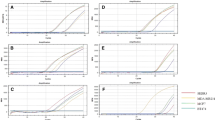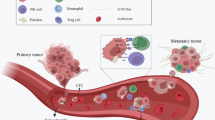Abstract
Survivin mRNA expression was detected in 69.2%–93.8% of primary breast carcinomas, but is rarely expressed in normal breast tissues and hematopoietic cells. The objective of this study was to investigate the significance that the detection of Survinin-expressing circulating breast cancer cells in the peripheral blood has on clinical outcomes. The detection method was based on a RT-PCR ELISA technique developed in our laboratory. Sixty-seven breast cancer patients in various stages and 135 normal healthy women were investigated. Survivin-expressing circulating cancer cells were detected in the peripheral blood samples from 34 (50.7%) out of 67 breast cancer patients, but not in the healthy women that were used as controls. The presence of Survivin-expressing circulating breast cancer cells was found to be significantly associated with various clinicopathological parameters such as vessel infiltration, histological grade, tumor size, nodal status, ER/PgR status, Her-2 status and clinical stages of the disease (P < 0.01). During a follow-up period of 36 months, 9 out of 11 (81.8%) breast cancer patients that had a positive Survivin-expressing at the time of the initial assay test suffered a relapse of the disease, whereas recurrence was only found in 2 out of 6 (33.3%) breast cancer patients that had a negative Survivin-expression. Thus, the detection of circulating cancer cells expressing Survivin mRNA could provide valuable information for the prediction of metastasis and recurrence of breast cancer.






Similar content being viewed by others
References
Ries LAG, Henson DE, Harras A (1994) Survival from breast cancer according to tumor size and nodal status. Surg Oncol Clin N Am 3:391–395
Mirza AN, Mirza NQ, Vlastos G, Singletary SE (2002) Prognostic factors in node-negative breast cancer. Ann Surg 235:10–26
Mansi JL, Gogas H, Bliss JM et al (1999) Outcome of primary-breast-cancer patients with micrometastases: a long-term follow-up study. Lancet 354:195–200
Tabar L, Duffy SW, Vitak B et al (1999) The natural history of breast carcinoma; what have we learned from screening? Cancer 86:449–462
Fisher B, Redmond C, Fisher ER et al (1985) Ten-year results of a randomized clinical trial comparing radical mastectomy and total mastectomy with or without radiation. N Engl J Med 312:674–681
Denley H, Pinder SE, Elston CW, Lee AHS, Ellis IO (2002) Preoperative assessment of prognostic factors in breast cancer. J Clin Pathol 54:20–24
Gilbey AM, Burnett D, Coleman RE et al (2004) The detection of circulating breast cancer cells in blood. J Clin Pathol 57:903–911
Traystman M, Cochran G, Hake S et al (1997) Comparison of molecular cytokeratin 19 reverse transcriptase polymerase chain reaction (CK 19 RT-PCR) and immunocytochemical detection of micrometastatic breast cancer cells in hematopoietic harvests. J Hematother 6:551–561
Jung R, Peterson K, Kruger W et al (1999) Detection of micrometastasis by cytokeratin RT-PCR is limited due to stable background transcription in granulocytes. Br J Cancer 81:870–873
Lopez-Guerrero JA, Bolufer-Gilabert P, Sanz-Alonso M et al (1997) Minimal illegitimate levels of cytokeratin K19 expression in mononucleated blood cells detected by a reverse transcription PCR method (RT-PCR). Clin Chim Acta 263:105–116
Bostick PJ, Chatterjee S, Chi DD et al (1998) Limitations of specific reverse-transcriptase polymerase chain reaction markers in the detection of metastases in the lymph nodes and blood of breast cancer patients. J Clin Oncol 16:2632–2640
Ambrosini G, Adida C, Altieri D (1997) A novel anti-apoptosis gene, survivin, expressed in cancer and lymphoma. Nat Med 3:917–921
Yamamoto T, Tanigawa NT (2001) The role of survivin as a new target of diagnosis and treatment in human cancer. Med Electron Microsc 34:207–212
Coradini D, Daidone MG (2004) Biomolecular prognostic factors in breast cancer. Curr Opin Obstet Gynecol 16:49–55
Span PN, Sweep FC, Wiegerinck ET et al (2004) Survivin is an independent prognostic marker for risk stratification of breast cancer patients. Clin Chem 50:1986–1993
Izawa A, Kobayashi D, Nasu S et al (2002) Relevance of c-erbB2, PLU-1 and survivin mRNA expression to diagnostic assessment of breast cancer. Anticancer Res 22:2965–2969
Nasu S, Yagihashi A, Izawa A et al (2002) Survivin mRNA expression in patients with breast cancer. Anticancer Res 22:1839–1843
Ryan B, O’Donovan N, Browne B et al (2005) Expression of survivin and its splice variants survivin-2B and survivin-DeltaEx3 in breast cancer. Br J Cancer 92:120–124
Fleming ID, Cooper JS, Henson DE et al (eds) (1997) American joint committee on cancer staging manual, 5th edn. JB Lippincott, Philadelphia
Ito T, Shiraki K, Sugimoto K et al (2000) Survivin promotes cell proliferation in human hepatocellular carcinoma. Hepatology 31:1080–1085
Sliva AL, Diamond MR, Passas-Coelho JL (2001) Cytokeratin 20 is not a reliable molecular marker for occult breast cancer cell detection in hematological tissues. Breast Cancer Res Treat 66:59–66
Sabbatini R, Federico M, Morselli M et al (2000) Detection of circulating tumor cells by reverse transcriptase polymerase chain reaction of maspin in patients with breast cancer undergoing conventional-dose chemotherapy. J Clin Oncol 18:1914–1920
Hoon DS, Sarantou T, Doi F et al (1996) Detection of metastatic breast cancer by beta-hCG polymerase chain reaction. Int J Cancer 69:369–374
Wasserman L, Dreilinger A, Easter D et al (1999) A seminested RT-PCR assay for HER2/neu initial validation of a new method for the detection of disseminated breast cancer cells. Mol Diagn 4:21–28
Zehentner BK, Persing DH, Deme A et al (2004) Mammaglobin as a novel breast cancer biomarker multigene reverse transcription-PCR assay and sandwich ELISA. Clin Chem 50:2069–2076
de Cremoux P, Extra JM, Denis MG et al (2000) Detection of MUC1-expressing mammary carcinoma cells in the peripheral blood of breast cancer patients by real-time polymerase chain reaction. Clin Cancer Res 6:3117–3122
An XY, Egami H, Hayashi N et al (2001) Clinical significance of circulating cancer cells in peripheral blood detected by reverse transcriptase-polymerase chain reaction in patients with breast cancer. Tokoku J Exp Med 193:153–162
Shinozwa I, Inokuchi K, Wakabayashi I et al (2000) Disturbed expression of the anti-apoptosis gene, survivin, and EPR-1 in hematological malignancies. Leuk Res 24:965–970
Moriai R, Asanuma K, Kobayashi D et al (2001) Quantitative analysis of the anti-apoptotic gene survivin expression in malignant haematopoietic cells. Anticancer Res 21:595–600
Mehes G, Witt A, Kubista E et al (2001) Circulating breast cancer cells are frequently apoptotic. Am J Pathol 159:17–20
Ross AA, Cooper BW, Lazarus HM et al (1993) Detection and viability of tumor cells in peripheral blood stem cells collections from breast cancer patients using immunocytochemical and clonogenic assay techniques. Blood 82:2605–2610
Al-Hajj M, Wicha MS, Benito-Hernandez A et al (2003) Prospective identification of tumorigenic breast cancer cells. Proc Natl Acad Sci USA 100:3983–3988
Pizzoferrato E, Liu Y, Gambotto A et al (2004) Ectopic expression of interferon regulatory factor-1 promotes human breast cancer cell death and results in reduced expression of survivin. Cancer Res 64:8381–8388
Author information
Authors and Affiliations
Corresponding author
Rights and permissions
About this article
Cite this article
Yie, SM., Luo, B., Ye, NY. et al. Detection of Survivin-expressing circulating cancer cells in the peripheral blood of breast cancer patients by a RT-PCR ELISA. Clin Exp Metastasis 23, 279–289 (2006). https://doi.org/10.1007/s10585-006-9037-7
Received:
Accepted:
Published:
Issue Date:
DOI: https://doi.org/10.1007/s10585-006-9037-7




